If you’ve ever stared at your small bedroom walls wondering why it still feels cramped, the answer might be in your color choices. The right palette can instantly make a space look larger, brighter, and more inviting.
I’ve experimented with countless bedroom makeovers, and I’ve seen how a smart color scheme can shift a room’s mood and proportions without moving a single piece of furniture.
Small bedrooms demand colors that work harder. They need to reflect light, create depth, and bring warmth without overwhelming the eye.
In this guide, I’ll share my favorite color palette ideas for small bedrooms that are practical, stylish, and easy to live with. Each one comes from both design principles and real-life experience, so you can confidently choose the one that works for your space.
Color Psychology in Small Spaces
Colors do more than decorate a room; they influence how you feel in it. In small spaces, every wall, ceiling, and trim color plays a role in either opening up the room or closing it in.
Lighter shades tend to make walls recede, creating the illusion of more space. Warm neutrals bring comfort without heaviness, while soft mid-tones can add personality without shrinking the room.
Even bolder shades can work, provided they’re balanced with lighter tones or strategic accents.
When I help friends or clients with small bedroom makeovers, I always ask how they want to feel in the room before we even talk about colors.
Do they want airy and refreshing, cozy and intimate, or stylish and layered? The answer shapes the palette entirely.
1. Color-Drench in a Soft Mid-Tone
Color-drenching means painting the walls, trim, and even the ceiling in the same shade. For small bedrooms, I prefer doing this with a soft mid-tone rather than a deep hue. This creates a cocoon-like feel without making the space feel boxed in.
For example, a muted sage green or dusty blue can make the walls feel like they melt away. By removing visual breaks between wall and trim, your eye flows smoothly across the room, making it feel more unified and expansive.
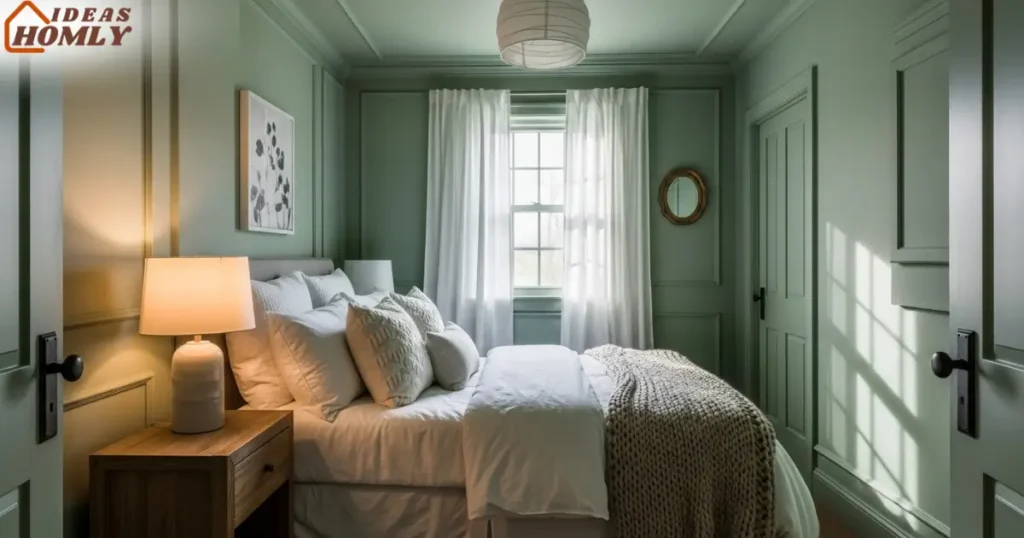
If you’re worried about the space feeling too flat, you can bring in varied textures. I’ve paired a color-drenched blue room with crisp white bedding and a chunky knit throw, and the result felt rich yet airy.
Quick tip: Stick with a finish that’s not too shiny. A soft matte or eggshell works beautifully for this look.
2. High-LRV Warm Neutrals for Light Boost
If your bedroom lacks natural light, high-LRV (Light Reflectance Value) colors are your best friend. LRV measures how much light a color reflects, and anything above 70 is considered high.
Warm neutrals like creamy ivory, pale beige, or soft taupe not only reflect more light but also keep the room from feeling sterile.
I’ve used these in windowless guest rooms, and they can genuinely trick the eye into thinking there’s more sunlight than there actually is.
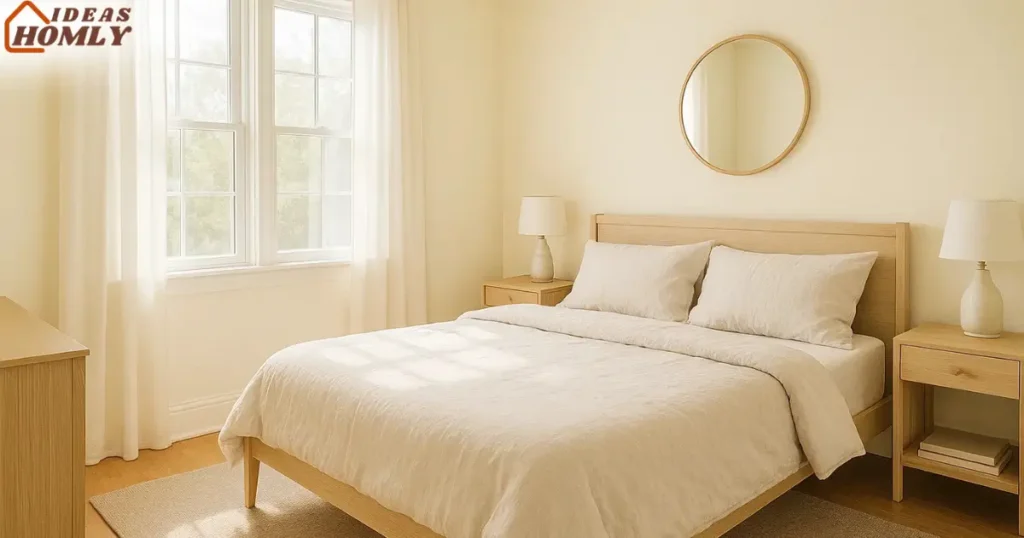
Here’s a simple comparison for reference:
| Color Type | Example Shade | LRV Range | Effect in Small Room |
|---|---|---|---|
| High-LRV Warm Neutral | Creamy Ivory | 80–85 | Bright, soft, inviting |
| Cool White | Pure White | 85–90 | Very bright but can feel cold |
| Mid-tone Neutral | Warm Taupe | 60–65 | Balanced, slightly cozier |
Adding subtle contrast with slightly darker furniture or a textured area rug keeps the look from being too plain.
3. Calm Analogous Combinations
Analogous color schemes use shades that sit next to each other on the color wheel. In a small bedroom, this creates a naturally calm and coordinated look.
The lack of sharp contrast keeps your eyes moving gently around the space, which can make it feel more relaxing.
One of my favorite bedroom makeovers used soft blue, blue-green, and teal accents. The walls were painted a pale blue-gray, the bedding had hints of seafoam, and a textured rug brought in a muted teal.
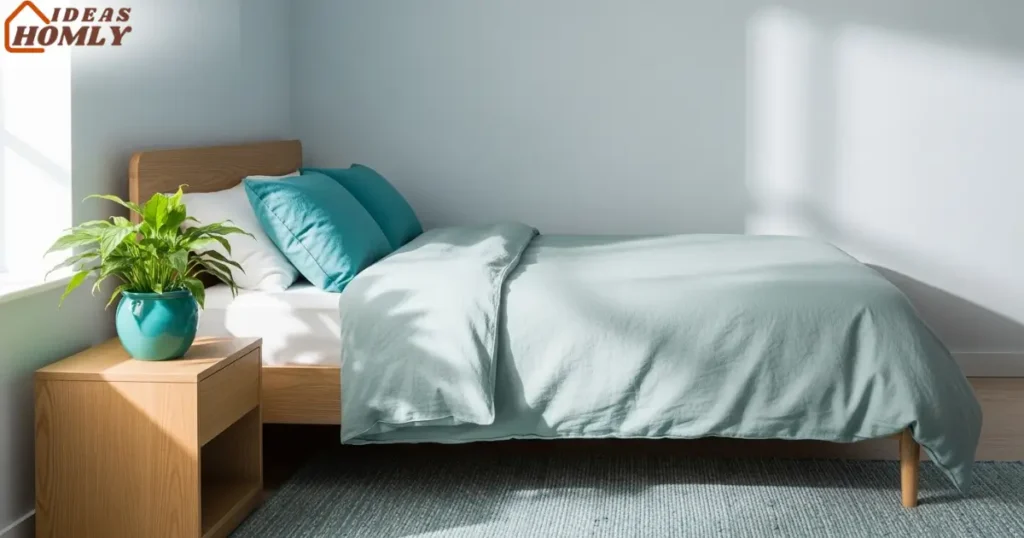
The harmony between these colors made the room feel peaceful without being boring.
You can also apply this concept with warmer tones, like peach, coral, and muted terracotta. Just keep the saturation low to avoid overpowering the room.
Layering tones of the same family also helps you avoid the “matchy-matchy” trap while still keeping things cohesive.
4. Split-Complementary Accents
A split-complementary palette gives you contrast without chaos. You start with a base color, then add the two shades that sit next to its opposite on the color wheel. It’s a great way to make small bedrooms more lively without overwhelming them.
For example, start with a muted green as your main color. Then, bring in coral and soft peach as accent tones through throw pillows, artwork, or a small upholstered bench. The contrast draws the eye in specific directions, adding dimension to the space.
The trick is to keep your base color dominant and your accent shades in smaller doses.
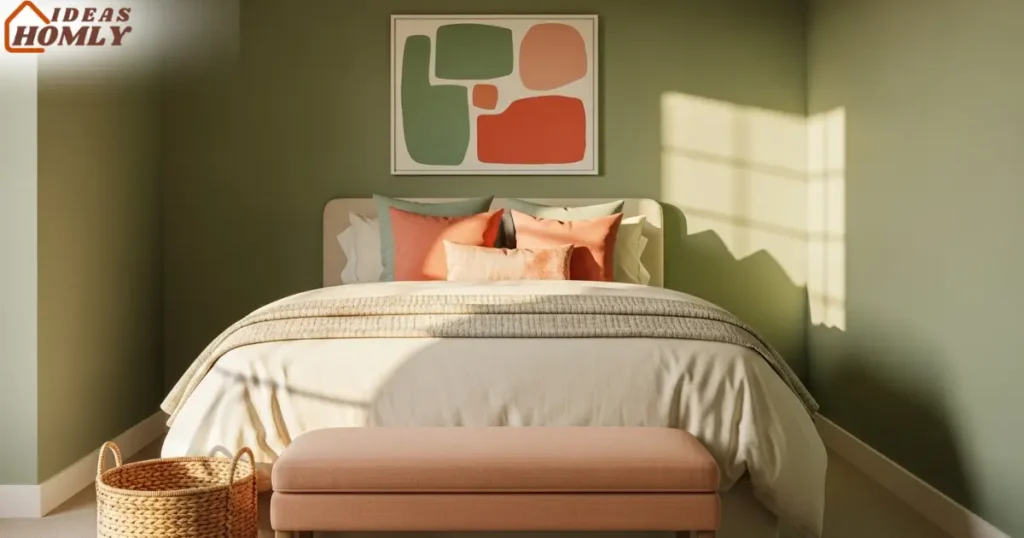
When I tested this in a compact guest room, I painted the walls a sage green, used a cream duvet, and added coral throw cushions. The room felt brighter and more energetic, yet still cozy enough to relax in.
5. Trend-Aware Tonal Softs
Trends come and go, but some color movements adapt beautifully to small spaces. Right now, I’m loving tonal softs, multiple shades of the same color family, but all in muted, understated tones. This keeps the room visually connected while adding depth.
Think dusty rose with blush, warm beige with sand, or muted olive with soft sage. The secret is to avoid one flat color throughout and instead layer different strengths of the same hue.
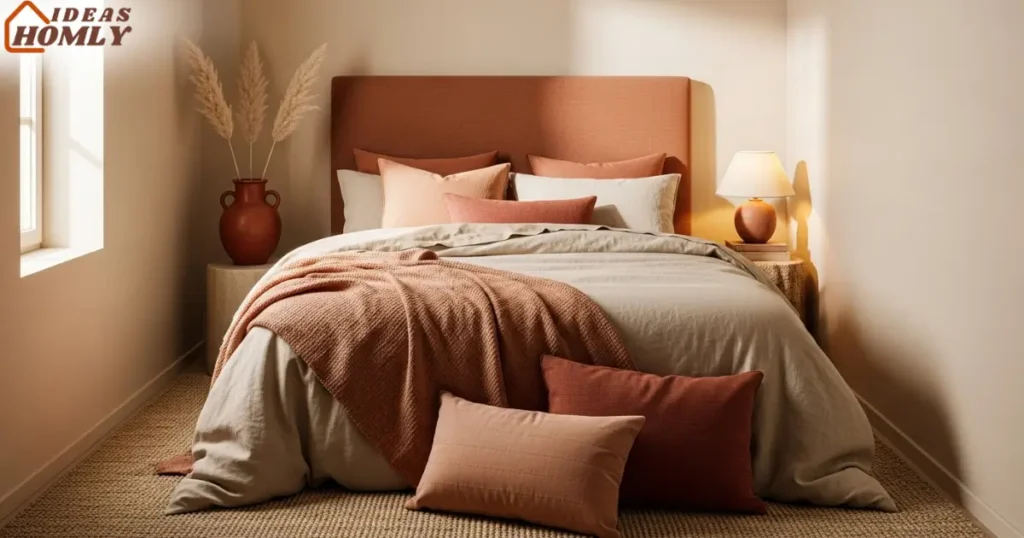
In one of my projects, I used three variations of a warm clay tone: the palest version on the walls, a slightly deeper one on the headboard, and the richest shade in small accessories like a ceramic vase.
Tonal softs also make it easy to refresh the look seasonally. Swap a few accents without repainting the whole room, and it still feels coordinated.
Tips for Testing Colors in a Small Room
Even the best color theory won’t save you if the shade looks different in your actual space. Paint reacts to lighting, room size, and surrounding colors, so testing is essential.
Here’s my go-to process:
- Sample generously: Paint large swatches on different walls so you can see how light hits them throughout the day.
- Check under different lighting: Morning sunlight, midday brightness, and evening lamp light can all change how a color reads.
- Pair with your furniture: Hold fabric samples, wood finishes, or decor pieces against the wall to make sure they harmonize.
- Live with it: Keep the swatches for at least a week. Sometimes a color you loved at first feels off after a few days.
When I tested a pale green for my own bedroom, it looked perfect in the morning but flat and gray at night. Switching to a warmer undertone fixed the problem instantly.
Conclusion
Choosing the best color palette for a small bedroom isn’t about following trends blindly, but it’s about finding shades that work with your light, your furniture, and the mood you want to create.
Soft mid-tone color-drenching can wrap the room in comfort. High-LRV warm neutrals bring a light boost to dim spaces.
Calm analogous schemes keep things serene, split-complementary accents add controlled contrast, and tonal softs offer a trend-aware yet timeless look.
When you test shades properly and think about how you want the room to feel, you’ll avoid costly repaints and instead enjoy a bedroom that feels intentional and inviting.
I’ve seen small bedrooms transform with nothing more than a smart color choice, and it still amazes me how much impact paint has for such a small investment.
FAQs
For windowless rooms, choose high-LRV warm neutrals to reflect the most light. Creamy ivory, pale beige, or warm greige can make the room feel brighter and less enclosed. Adding mirrors can further boost the light effect.
Yes, but do it strategically. Color-drenching in a soft mid-tone or pairing a darker accent wall with lighter surroundings can create depth without making the room feel cramped. Balance the darker color with light bedding, curtains, and furniture.
Bold colors work if used sparingly. With split-complementary schemes, you can add pops of coral, mustard, or teal through throw pillows, artwork, or small furniture pieces. Keep the walls neutral or soft to avoid visual overload.
Natural and artificial lighting change how a color appears. A pale green can look fresh in morning sunlight but dull under warm evening bulbs. That’s why testing on all walls and at different times of day is essential before committing.
If your base color still works, swap out bedding, curtains, and accessories in a new tonal range. For example, if your room is painted in soft beige, introduce seasonal accents like blush and clay for warmth, or sage and cream for a cooler, fresh look.

